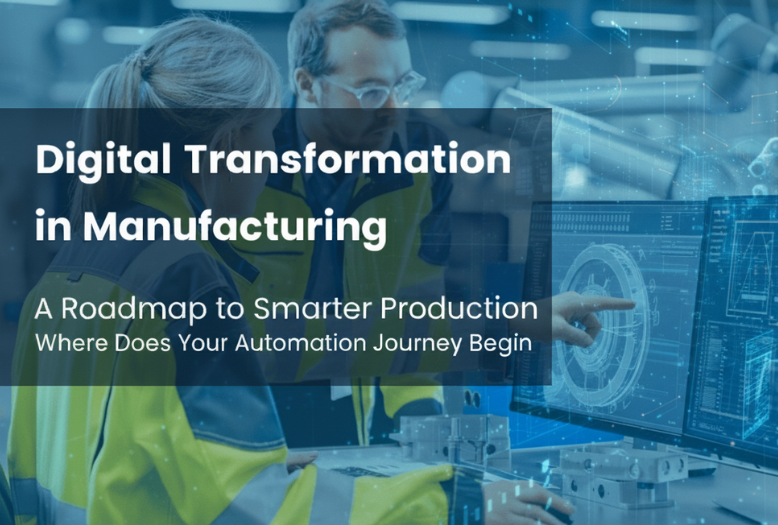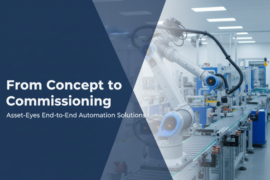Ever stood on your factory floor wondering, “Where do I even start with modernization?” while watching decades-old control panels manage your production line? The manufacturing world is filled with buzzwords like “Industry 4.0,” “IoT sensors,” and “predictive maintenance,” making the path forward feel overwhelming. Here’s the thing: successful digital transformation in manufacturing doesn’t require you to overhaul everything at once. In fact, the most effective automation journeys begin with a solid foundation and that foundation is often simpler than you might think. Let’s explore where your modernization journey should actually begin and how the right approach can set you up for long term success.
1. Why Your Documentation Matters More Than You Think – Digital Transformation in Manufacturing
Before we dive into sensors, cloud platforms, or AI-powered analytics, let’s talk about something that often gets overlooked: your biggest competitive advantage in digital transformation isn’t the latest technology, it’s having accurate, up-to-date documentation of your existing systems.
Think about it this way: would you renovate your house without knowing where the electrical wiring runs? Of course not. Yet in many industrial settings, teams begin planning smart upgrades like sensor networks, modern PLCs, or advanced control layers without a full, documented picture of how their current electrical or motor control panels are laid out.
Here’s what happens when documentation is missing or outdated:
- Integration projects take 2-3 times longer than expected
- Troubleshooting becomes a guessing game that extends downtime
- Safety risks increase when technicians work with unclear schematics
- Future upgrades become exponentially more complex and expensive
Modern manufacturing facilities that successfully implement digital transformation share one common trait: they have precise, manufacturing ready documentation that serves as the roadmap for every upgrade and integration.
2. Where Your Automation Journey Should Actually Begin
Start with a Documentation Audit
Your first step isn’t buying new hardware, it’s understanding what you currently have. Walk through your facility and ask yourself:
- Do you have current CAD drawings for your control panels?
- Are your electrical schematics accurate and digitally accessible?
- Can a new technician understand your system layout without extensive explanation?
- Do your general assembly drawing reflect recent modifications?
If you’re answering “no” to these questions, you’ve found your starting point.
Identify Your Biggest Pain Points
Successful digital transformation addresses real operational challenges, not just technology for technology’s sake. Common pain points that benefit from automation include:
- Unplanned downtime from equipment failures
- Quality variations that could be avoided through improved monitoring.
- Energy waste from inefficient system operation
- Manual processes that slow down production
Each of these challenges points to specific areas where digital upgrades can deliver immediate value, but only if you have the foundational documentation to implement them correctly.
Prioritize Control System Modernization
Your control systems are the nervous system of your facility. Legacy systems often create barriers to digital transformation because they use proprietary protocols, lack connectivity options, or simply can’t handle modern data requirements.
Modern programmable logic controllers (PLCs) and distributed control systems (DCS) offer several advantages:
- Standard communication protocols that integrate with IoT devices
- Better data access for analytics and monitoring
- Easier integration with enterprise systems
- Enhanced security features for industrial networks
But here’s the crucial part: modernizing these systems requires precise electrical control panel design and motor control panel design documentation. Without it, you’re essentially flying blind during one of the most critical phases of your transformation.
3. Building Your Digital Infrastructure Foundation – Digital Transformation in Manufacturing
Network and Communication Systems
Once you have modern control systems in place, you need the digital infrastructure to support advanced manufacturing capabilities. Industrial networks require special consideration because they carry both operational data and control signals.
Your network design must prioritize:
- Reliability for continuous operation
- Security to protect against cyber threats
- Sufficient bandwidth for real time communication
- Scalability for future digital initiatives
Many manufacturers adopt hybrid approaches that keep critical control data local while storing analytical data in cloud platforms. This strategy balances performance requirements with the flexibility needed for advanced analytics.
Data Management and Storage
As you generate more information from your operations, data management becomes increasingly important. Contemporary manufacturing facilities gather data from a variety of sources:
- Sensor readings from production equipment
- Quality measurements from inspection systems
- Energy consumption from monitoring devices
- Maintenance records from work order systems
Effective data management requires both technical infrastructure and clear processes for data collection, storage, and analysis. Cloud platforms offer scalable storage solutions, but you’ll need to consider latency requirements and security concerns when designing your data architecture.
4. Implementing Monitoring and Analytics Capabilities
Start with Operational Dashboards
Start with fundamental operational dashboards that offer real time insight into your production processes. These dashboards help operators respond more quickly to issues and make data-driven decisions about production optimization.
Effective dashboards display:
- Key performance indicators (KPIs) for production efficiency
- Equipment status and alarm information
- Quality metrics and trends
- Energy consumption patterns
Progress to Predictive Analytics
As you gain experience with basic monitoring, you can implement predictive analytics that forecast equipment failures, quality issues, and maintenance needs. This capability transforms your maintenance approach from reactive to proactive, reducing downtime and extending equipment life.
Predictive systems examine historical data alongside real time sensor inputs to detect patterns signaling potential issues. Common applications include:
- Vibration analysis for rotating equipment
- Temperature monitoring for electrical systems
- Process parameter trending for quality prediction
- Energy usage analysis for efficiency optimization
Consider Advanced Integration
Integration with enterprise systems becomes increasingly valuable as your digital capabilities mature. Connecting your production systems with ERP, MES, and quality management systems creates a comprehensive view of your operations.
This integration enables:
- Better production planning and scheduling
- Faster response to quality issues
- More accurate performance measurement
- Improved inventory management
5. Common Implementation Challenges and Solutions
Change Management
Digital transformation often requires new ways of working, which can create resistance among your team. Involve your operators and maintenance staff in the planning process, provide adequate training, and clearly communicate the benefits of new systems.
Cybersecurity Concerns
As you connect operational systems to networks and cloud platforms, cybersecurity becomes more complex. Implement layered security approaches that protect both your control systems and your data. Regular security assessments and updates help maintain protection as threats evolve.
Budget Constraints
You don’t need to transform everything at once. Focus on projects that provide clear returns on investment and use those successes to justify additional investments. Many manufacturers find that starting with smaller, focused projects builds confidence and expertise for larger initiatives.
6. How Asset-Eyes Guides Your Modernization Journey
The path of digital transformation in manufacturing can be confusing, but you don’t have to go it alone. At Asset-Eyes, we understand that successful automation projects begin with a solid foundation of accurate, detailed documentation.
Our CAD drafting services provide the manufacturing ready documentation that makes your digital transformation possible. Whether you’re updating legacy electrical control panel design, creating new motor control panel design documentation, or preparing general assembly drawings for equipment upgrades, our team delivers the precision and clarity your projects demand.
Through our solidworks drafting services, we ensure that every component, connection, and specification is clearly documented for your engineering teams, automation vendors, and maintenance staff. Our expertise in HVAC CAD drafting extends to complex industrial systems, providing the technical accuracy needed for successful control system modernization.
We don’t design your automation strategy, we empower it with the right technical documentation. Our 2d drafting in solidworks capabilities ensure that your modernization efforts are built on accurate, comprehensive plans that minimize errors and reduce implementation time.
Your digital transformation journey begins with clarity and precision in your control system documentation. Without accurate plans, even the most advanced technologies can falter. By ensuring your foundational elements are meticulously documented, you empower your teams, streamline your processes, and unlock the full potential of your modernized manufacturing operations.
Contact Us Now:
📞 +91 9840895134






